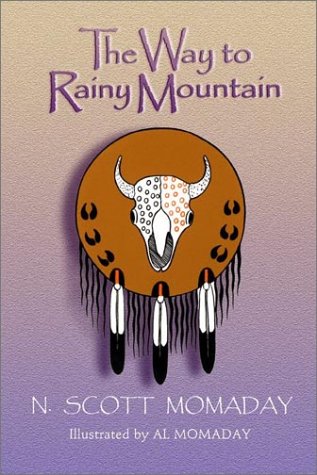English language
Published Jan. 20, 1967 by University of New Mexico Press.

English language
Published Jan. 20, 1967 by University of New Mexico Press.
The Way to Rainy Mountain (1969) is a book by Pulitzer Prize winning author N. Scott Momaday. It is about the journey of Momaday's Kiowa ancestors from their ancient beginnings in the Montana area to their final war and surrender to the United States Cavalry at Fort Sill, and subsequent resettlement near Rainy Mountain, Oklahoma. The Way to Rainy Mountain is a blend of history, folklore, and poetic memoir and was published in 1969. It takes the reader through author N. Scott Momaday’s own journey of discovering his Kiowa background and identity. The journey is told in three separate voices: The first voice, the ancestral voice, tells about the Kiowa by using oral traditions and myths; the second voice is a historical commentary; and finally, the third voice is Momaday’s poetic memoir of his experiences. All three voices together teach about the Kiowa’s origin, beliefs, traditions, morals, and conflicts. Not …
The Way to Rainy Mountain (1969) is a book by Pulitzer Prize winning author N. Scott Momaday. It is about the journey of Momaday's Kiowa ancestors from their ancient beginnings in the Montana area to their final war and surrender to the United States Cavalry at Fort Sill, and subsequent resettlement near Rainy Mountain, Oklahoma. The Way to Rainy Mountain is a blend of history, folklore, and poetic memoir and was published in 1969. It takes the reader through author N. Scott Momaday’s own journey of discovering his Kiowa background and identity. The journey is told in three separate voices: The first voice, the ancestral voice, tells about the Kiowa by using oral traditions and myths; the second voice is a historical commentary; and finally, the third voice is Momaday’s poetic memoir of his experiences. All three voices together teach about the Kiowa’s origin, beliefs, traditions, morals, and conflicts. Not only does the journey recounted in this book help Momaday better understand his ancestry, it also teaches about the Kiowa tribe’s history. The uniqueness of this text, however, has been an issue for some readers; they claim it is confusing to follow. Others find it easier to understand by reading each individual voice consecutively instead of alternating from one voice to another as the book is written. The Way to Rainy Mountain continues to be an entry point to Kiowa history and a way to open discussions about what constitutes any history of a people.